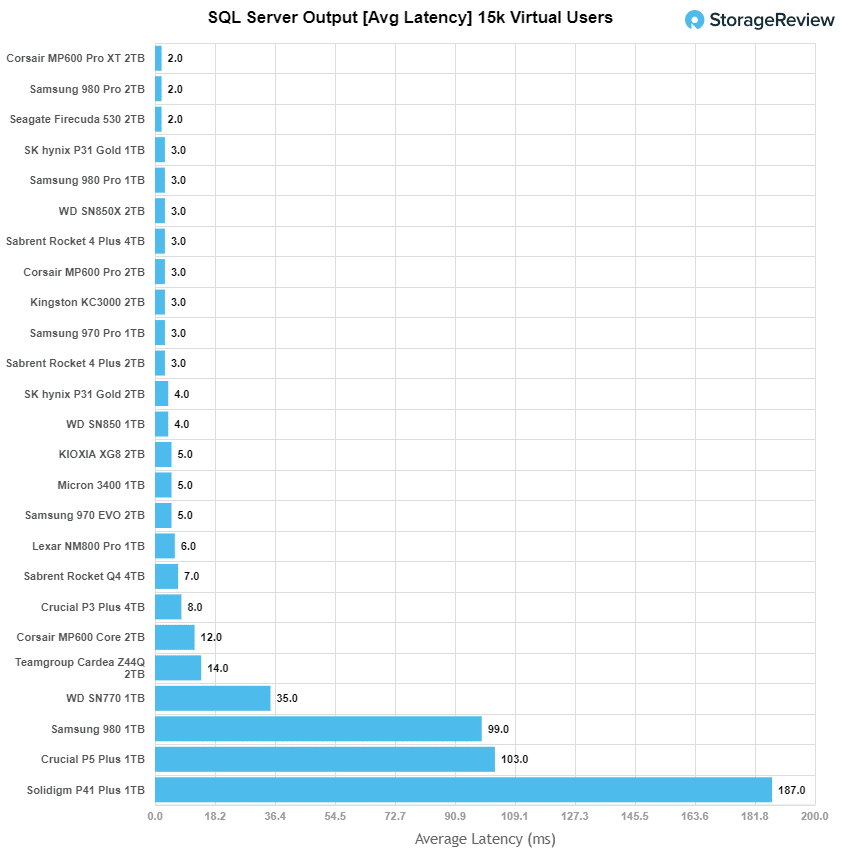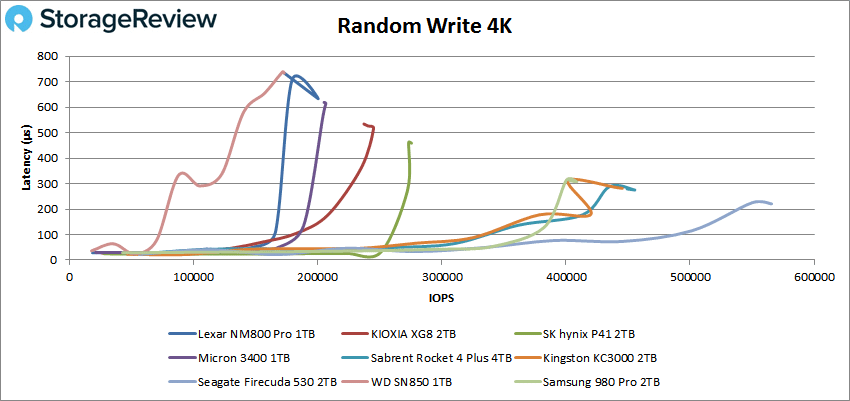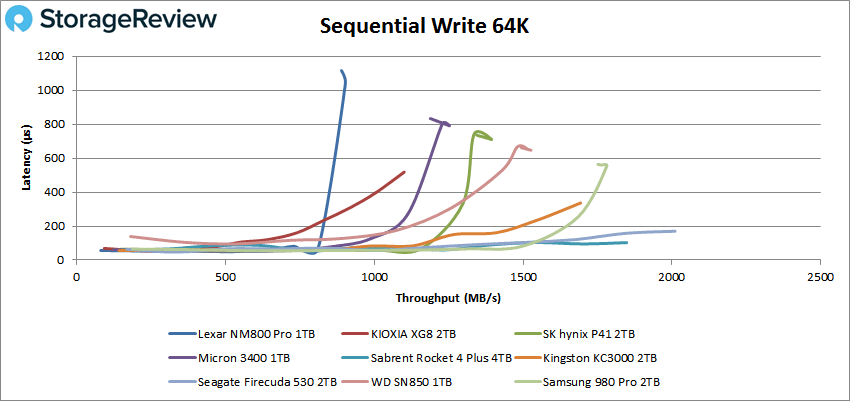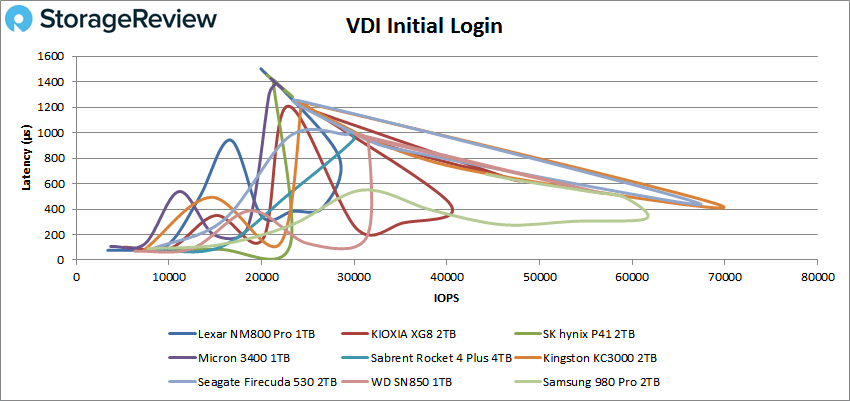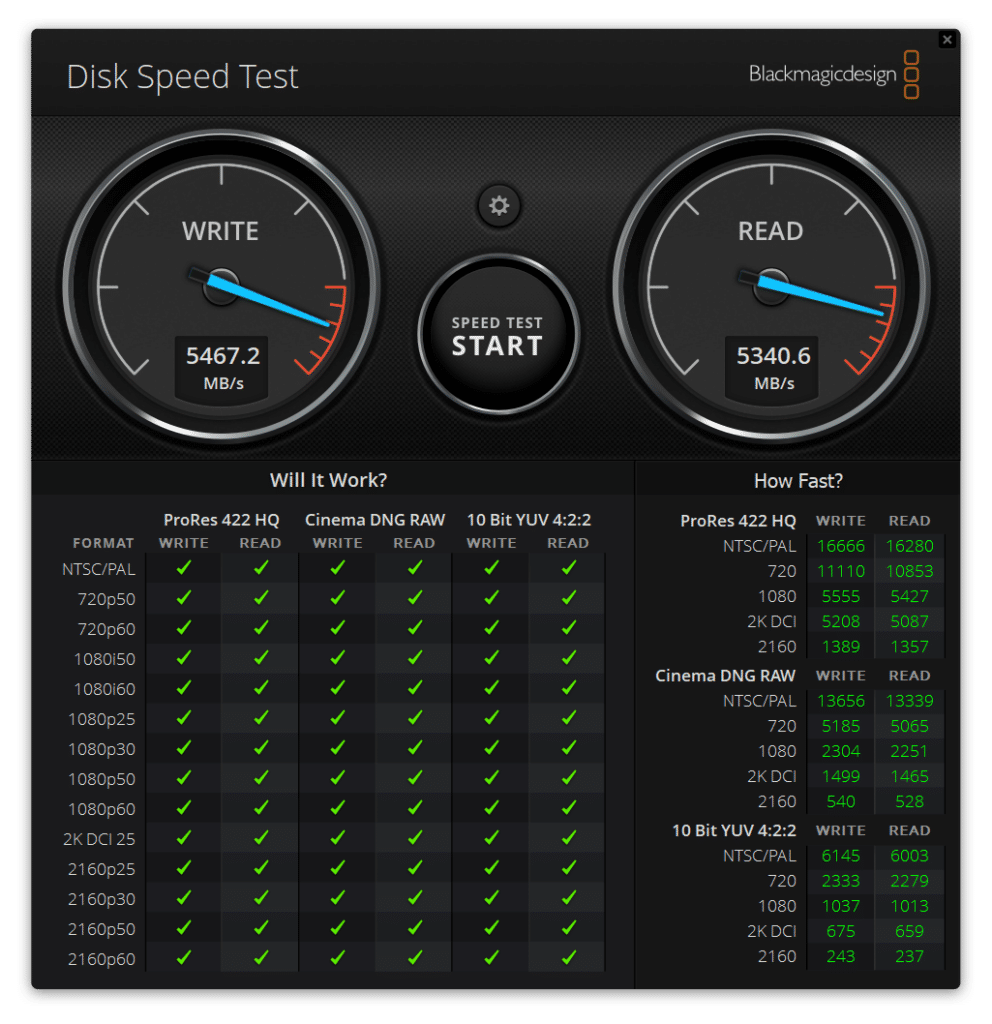The Lexar NM800 Pro is the company’s newest PCIe Gen4 NVMe SSD to hit the market for gamers, professionals, and creators. Powered by 3D TLC NAND and a 12nm INNOGRIT 1G5236CAA controller, the NM800 Pro is available in capacities up to 2TB in the M.2 (2280) form factor.
The Lexar NM800 Pro is the company’s newest PCIe Gen4 NVMe SSD to hit the market for gamers, professionals, and creators. Powered by 3D TLC NAND and a 12nm INNOGRIT 1G5236CAA controller, the NM800 Pro is available in capacities up to 2TB in the M.2 (2280) form factor.
 Lexar NM800 Pro Features
Lexar NM800 Pro Features
For performance, Lexar quotes the usual speeds for PCIe Gen4 drives, including up to 7.5GB/s read and 6.5GB/s write in sequential transfer rates for the 2TB model. The 1TB version offers slightly slower write speeds of 6.3GB/s while the 512TB is quoted at 7.45GB/s read and 3.5GB/s write.
Looking at reliability, the NM800 Pro is rated at 2,000TB for TWB (total bytes written) and 1.5 million hours MTBF (Mean Time Between Failures), respectively. The latter value is a little less than what we’re used to seeing for consumer drives; for example, the recent Solidigm P41 Plus and WD Black SN850X are rated at 1.6 million hours and 1.75 million hours, respectively.
The NM800 Pro also features an integrated heatsink model to reduce thermal issues (Lexar indicates it can reduce temperatures by up to 30%), which can help improve performance consistency and power efficiency during heavy workloads and graphics-intensive gaming. The heatsink is also helpful for use with installations that don’t have a lot of airflow, like installing it inside a Sony PS5, which is supported by this drive.
We didn’t test the heatsink model for our review, so we can’t really comment on whether or not these claims from Lexar are true and if there are any noticeable real-world improvements. Nonetheless, it’s available for those who think they might be pushing the drive to its limits.
Backed by a limited 5-year warranty, the NM800 Pro goes for roughly $100 (512GB), $170 (1TB), and $280 (2TB) at Amazon. We will be looking at the 1TB model for this review.
Lexar NM800 Pro Specifications
| Capacity | 512GB, 1TB, 2TB |
| Form Factor | M.2 2280 |
| NAND / Controller | 3D TLC, INNOGRIT 1G5236CAA controller |
| Performance (Sequential) |
|
| Shock Resistant | 1500G, duration 0.5ms, Half Sine Wave |
| Vibration Resistant | 10~2000Hz, 1.5mm, 20G, 1 Oct/min, 30min/axis (X,Y,Z) |
| TBW |
|
| DWPD | 0.535 |
| MTBF | 1,500,000 Hours |
| Operating Temperature | 0°C to 70°C (32°F to 158°F) |
| Storage Temperature | -40°C to 85°C (-40°F to 185°F) |
| Dimension (LxWxH) | 80 x 22 x 10 mm / 3.15” x 0.87” x 0.39” |
| Weight | 54g / 0.12lbs |
| Warranty | Five-year limited warranty |
Testbed
As we migrate into testing newer NVMe Gen4 SSDs, it required a platform shift in our lab to support the newer interface. We’ve also been migrating newer NVMe Gen3 SSDs to the same platform for better apples-to-apples comparisons between drive generations. For these reviews, we leverage the Lenovo ThinkSystem SR635 server, equipped with an AMD 7742 CPU and 512GB of 3200Mhz DDR4 memory.
NVMe is tested natively through an M.2 to PCIe adapter card in the edge-card slot, while U.2 drives are loaded in the front. The methodology used better reflects end-user workflow with the consistency, scalability, and flexibility testing within virtualized server offers. A large focus is put on drive latency across the entire load range of the drive, not just at the smallest QD1 (Queue-Depth 1) levels. We do this because many of the common consumer benchmarks don’t adequately capture end-user workload profiles.
For our added BlackMagic Disk Speed Test performed in Windows, we use our self-built StorageReview desktop.
Lexar NM800 Pro Performance
We are reviewing the 1TB version of the Lexar NM800 Pro drive and will be comparing it to the following PCIe Gen4x4 drives:
- Micron 3400
- Kingston KC3000
- Sabrent Rocket 4 Plus (4TB) – Updated
- Samsung 980 Pro
- Seagate Firecuda 530
- Western Digital SN850
- SK Hynix P41
- KIOXIA XG8
SQL Server Performance
Each SQL Server VM is configured with two vDisks: 100GB volume for boot and a 500GB volume for the database and log files. From a system resource perspective, we configured each VM with 16 vCPUs, 64GB of DRAM and leveraged the LSI Logic SAS SCSI controller. While our Sysbench workloads tested previously saturated the platform in both storage I/O and capacity, the SQL test is looking for latency performance.
This test uses SQL Server 2014 running on Windows Server 2012 R2 guest VMs and is stressed by Quest’s Benchmark Factory for Databases. StorageReview’s Microsoft SQL Server OLTP testing protocol employs the current draft of the Transaction Processing Performance Council’s Benchmark C (TPC-C), an online transaction-processing benchmark that simulates the activities found in complex application environments.
The TPC-C benchmark comes closer than synthetic performance benchmarks to gauging the performance strengths and bottlenecks of storage infrastructure in database environments. Each instance of our SQL Server VM for this review uses a 333GB (1,500 scale) SQL Server database and measures the transactional performance and latency under a load of 15,000 virtual users.
SQL Server Testing Configuration (per VM)
- Windows Server 2012 R2
- Storage Footprint: 600GB allocated, 500GB used
- SQL Server 2014
- Database Size: 1,500 scale
-
- Virtual Client Load: 15,000
- RAM Buffer: 48GB
- Test Length: 3 hours
-
- 2.5 hours preconditioning
- 30 minutes sample period
Looking at SQL Server average latency, the Lexar NM800 Pro had an average latency of 6ms, placing near the lower-mid portion of the leaderboard (though still solid).
VDBench Workload Analysis
When it comes to benchmarking storage devices, application testing is best, and synthetic testing comes in second place. While not a perfect representation of actual workloads, synthetic tests do help to baseline storage devices with a repeatability factor that makes it easy to do apples-to-apples comparison between competing solutions. These workloads offer a range of different testing profiles ranging from “four corners” tests, common database transfer size tests, to trace captures from different VDI environments.
All of these tests leverage the common vdBench workload generator, with a scripting engine to automate and capture results over a large compute testing cluster. This allows us to repeat the same workloads across a wide range of storage devices, including flash arrays and individual storage devices. Our testing process for these benchmarks fills the entire drive surface with data, then partitions a drive section equal to 1% of the drive capacity to simulate how the drive might respond to application workloads. This is different than full entropy tests which use 100% of the drive and take them into a steady state. As a result, these figures will reflect higher-sustained write speeds.
Profiles:
- 4K Random Read: 100% Read, 128 threads, 0-120% iorate
- 4K Random Write: 100% Write, 64 threads, 0-120% iorate
- 64K Sequential Read: 100% Read, 16 threads, 0-120% iorate
- 64K Sequential Write: 100% Write, 8 threads, 0-120% iorate
Starting with 4K random read, the Lexar NM800 Pro showed a peak performance of just 437K IOPS at 290.4µs, which placed it near the bottom of the leaderboard and just better than the Micron drive.

Moving onto sequential read 64K, the Lexar NM800 Pro had much better results, peaking at 5.3GB/s (or 85K IOPS) with 371µs latency, which was among the better performing drives and pretty much identical peak performance to the SK Hynix and KIOXIA drives
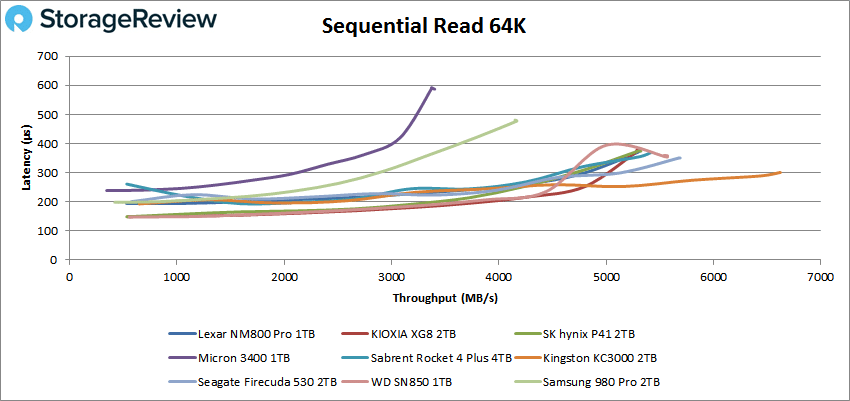
Next, we looked at our VDI benchmarks, which are designed to tax the drives even further. These tests include Boot, Initial Login, and Monday Login. Starting with Boot, the Lexar NM800 Pro had a peak of 70k IOPS (at 510.5µs) after which suffered from another spike in performance. This placed it near the bottom of the pack.
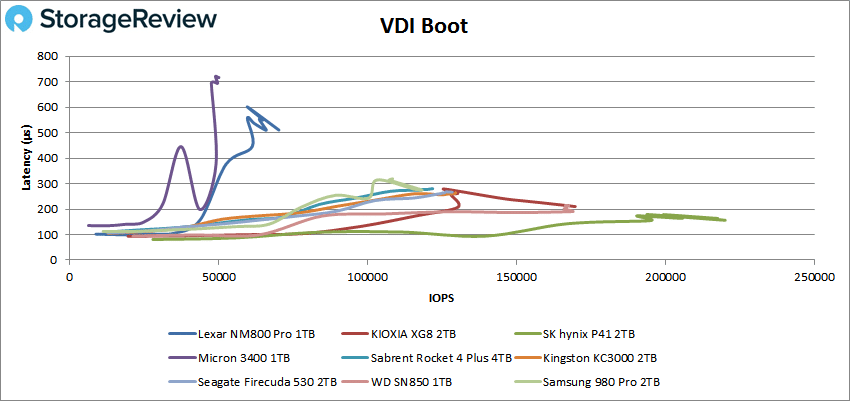
Finally, VDI Monday Login, the Lexar NM800 Pro again fell behind, peaking at just 17K IOPS with a latency of 927µs.
Lexar NM800 Pro Blackmagic Performance
Lastly is our Blackmagic transfer speed test, where we measure transfer speeds inside our consumer test platform. Here the Lexar NM800 Pro measured 5,340MB/s read and 5,467MB/s write. While these were fairly good results, they still weren’t as good as other consumer-grade PCIe Gen4 drives like the WD Black SN850X, which posted up to 5.77GB/s read and 6.01GB/s write.
Conclusion
The Lexar NM800 Pro is a PCIe Gen4 SSD designed for a range of demanding consumer use cases (like gaming and creation); however, it had a very uneven showing during our benchmarking, which makes us question whether it’s a suitable solution for these applications. The NM800 Pro is available in capacities up to 2TB and features 3D TLC NAND, PS5 compatibility, as well as a rating of 2,000TB and 1.5 million hours for TBW and MTBF, respectively.
The NM800 Pro yielded disappointing results during our performance tests, often finding itself near the bottom part of the leaderboard among the other tested TLC-based SSDs. Specifics include 437K IOPS in 4K random reads, 200K IOPS in 4K random writes, and 5.3GB/s (or 85K IOPS) in sequential reads. It couldn’t crack the 1GB/s mark for sequential write performance, only peaking at 903MB/s (or 14K IOPS). It did, however, show decent results in SQL server performance, posting 6ms in average latency.
Its poor performance continued during our VDI benchmarks (our suite of tests that tax the drives even further): our Boot profile showed a peak of 70K IOPS, while initial and Monday login tests topped out at just 28K IOPS and 17K IOPS, respectively.
While the NM800 Pro does feature a 2TB version with an integrated heatsink and heat spreader, not much else sets this drive apart from the other PCIe Gen4 drives out there. If it was noticeably cheaper than other competing drives, the Lexar NM800 Pro might be a viable option for the budget-minded consumer; however, its pricing model of $100, $170, and $280 for the 512GB, 1TB, and 2TB, respectively, is certainly not ideal due to its lackluster performance.
This is more expensive than other TLC SSDs like the WD SN850X, SK hynix P41 and Samsung 980 Pro, all of which are superior drives in almost every way. So, unless Lexar significantly drives down the MSRP price tag, we can’t recommend the NM800 Pro, especially since they are positioning it as a performance-driven SSD for gamers and content creators.
Engage with StorageReview
Newsletter | YouTube | Podcast iTunes/Spotify | Instagram | Twitter | TikTok | RSS Feed


